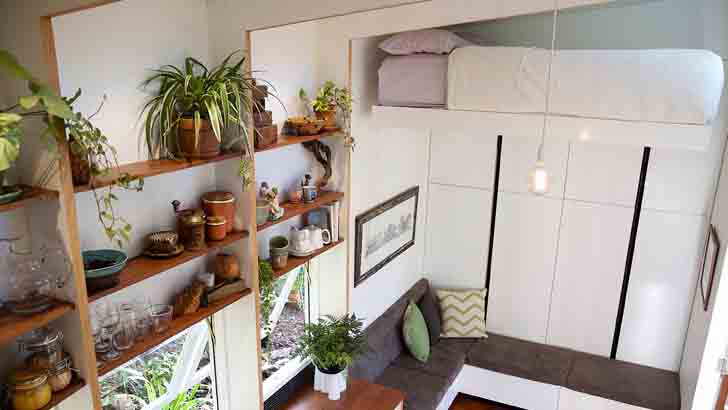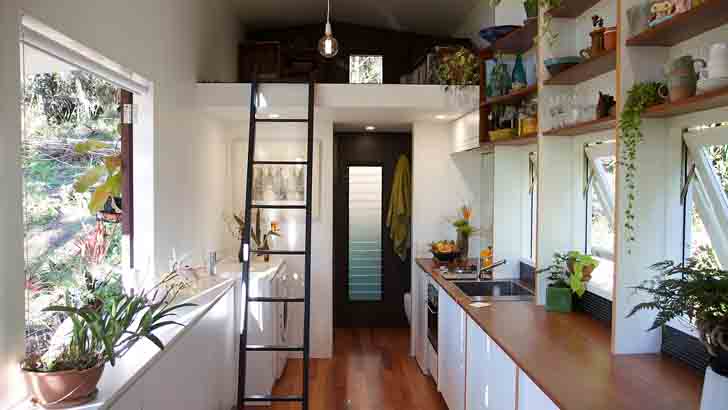A beginner's guide to designing and building a tiny house
By Richard Scott
So you want to be a homeowner?
If you're willing to lower your expectations - and, crucially, your square-metre count - you could own your own place for roughly the cost of a family car.
In Templestowe, Victoria, Fred Schultz, 56, built his house from scratch for just $33,000, plus $12,000 to take it off-grid.
Considering the median Melbourne house price is $710,000, that's a saving of $677,000, provided, of course, that you have a piece of land to put it on.
Made of corrugated steel with a plantation pine interior, Schultz's house is just 5.4m long and 2.5m wide - about the size of a Toyota HiLux - and 4m high.
He squeezed in a kitchen, lounge, composting toilet and bath, plus a loft area for sleeping. He has solar power, rainwater tanks and an alcohol-fuelled stove.
So what is a tiny house?
A tiny house is slightly smaller than your average one-bedroom apartment.
Generally, any property with a total internal floor space of 40 sqm or less is considered tiny.
If you're handy, you can build one yourself but there are companies that either custom-make them or send out a kit. Many, like Schultz's, are mounted on bespoke trailers, allowing you to change your view on a whim.
Who is suited to tiny home life?
"Anybody looking for a semi-permanent, low-rent housing scenario," says Lara Nobel from the Tiny House Company.
"Most interest comes from singles and younger couples.
But tiny houses can also cater to downsizers or those looking to add a granny flat or rentable space to their existing property." Logistically, a tiny house presents a challenge for larger families, and limits in accessibility may not suit the elderly or incapacitated.
Can I build my own tiny house?

"Why not?" says Schultz.
"The tiny-house movement isn't a new occurrence; it just became popular. Native Americans lived in teepees for centuries, the Inuit people had igloos, indigenous Australians had stone huts. People have always had smaller dwellings. The only difference now? They didn't spend 35 years of their lives paying them off."
What does it cost to build a tiny house?
Schultz's house may have cost him $45,000 in materials, tools and labour (he brought in professional installers and plumbers) but that figure, he warns, doesn't tell the whole story.
"Often people overlook the cost of being off work for a year, or the amount of family support required to complete a project of this magnitude."
Working with salvaged or donated materials (Schultz utilised the online classified site Gumtree) can cause a headache, too. "Just the process of gathering, collecting, transporting, de-nailing, cutting and straightening wood can use up all your time. There's a lot to factor in." An artist and former chemist by trade, Schultz spent 18 months building his little house, plus "several years" of planning it.
Should I DIY or buy a pre-built tiny home?
If you don't have the time or the skills, it might be cheaper (and safer) to consider a pre-made version.
For example, Brisbane's Tiny House Company sells a range of portals, from single serviced rooms ($54,000) to studio-style houses ($79,000) built on flat-deck trailers.
The tiny house model measures 2.5m by 7.5m with a 3.5m ceiling, and includes a bathroom (grey-water toilet, shower), kitchen (stove, sink) and lounge space with retractable bed. It takes between two and three months to build and is registered to be towed on the road.
Additionally, the company sells a "shell" house ($49,000) for those who fancy a semi-DIY project. This comes watertight and lockable but all internal fitout (electrical, plumbing, cabinetry) is up to you.
Where can I park my tiny house?
That's the tricky part, says Anthea Digiaris, associate and accredited property law specialist at Slater and Gordon.
"In Australia different municipalities have differing rules and regulations in terms of planning requirements, zoning and building permits.
It can be a bit of a minefield."
If you own land and you propose to build a tiny house on the land you should consult with your local council.
Councils regulate how your land can be used, including the type and size of a building and even the materials. Additional zoning regulations may require a minimum size for residential dwellings.
What if I have no land?

No problem, says Nobel.
"Social media, and Facebook in particular, can help connect those wanting to rent out spare space from between $40 and $100 per week. Others may plan collectively to purchase rural land; many park for free with friends and family."
Schultz began leasing land from a mate, but after buying his two-bedroom house he now keeps his original tiny house in the garden.
"A huge sticking point is length of habitation, since living on somebody else's land is considered 'camping'," he cautions.
"It varies by state but in Victoria the maximum time you can stay is only six weeks.
But, argues Digiaris, the relative novelty of the tiny house movement has meant that in many respects the law is yet to catch up and adapt.
If you lease or licence a space from a third party which will be used to build or park a tiny house, you should get independent legal advice and document any lease or licence agreement in writing.
Should I build a tiny house or granny flat?
"An ancillary dwelling or granny flat may be a preferable alternative [to a tiny house] as their construction may not be restricted by minimum size restraints but may however be subject to maximum size restrictions," says Digiaris.
However, ancillary dwellings generally need to be on the same lot as the main dwelling.
"You may not be able to build your tiny house on an empty lot if you classify it as ancillary."
What if I don't tell council?
"With a fixed tiny house, they can by rights demolish the entire structure if the appropriate permit approvals have not been obtained," says Digiaris.
"It's quite serious."
If you are rumbled - through a building inspection or neighbour dobbing you in - the council will serve a notice on the landowner. You'll then have 30 to 60 days to seek the appropriate permits. Failing that, your case will be taken to a tribunal and your new tiny house may, potentially, be razed.
Trying to sell a property with an unlawful structure can also get you into hot water down the track when it comes to permits and disclosures.
"It's just not worth cutting corners," says Digiaris.
"If you're caught out, it becomes a much bigger problem to fix retrospectively."
How do I get started?
Before ditching all your worldly possessions, it might pay to do a little test-run of living small.
On Airbnb you'll find plenty of pint-size cottages, yurts, bungalows and tree houses all over the country.
Many companies, including Schultz's (Fred's Tiny Houses), run workshops offering advice on how to build or where to put your tiny house.
Schultz's top tip for those planning to downsize?
Have a plan: "Design is everything in a tiny house, even more so when it's on wheels. You need to know what your needs are, not just personally but, in my case, as a couple and as a family. It's a game of competing priorities, and of millimetres and kilograms."
RELATED: How to build a shipping container home for less than $150k
Get stories like this in our newsletters.



